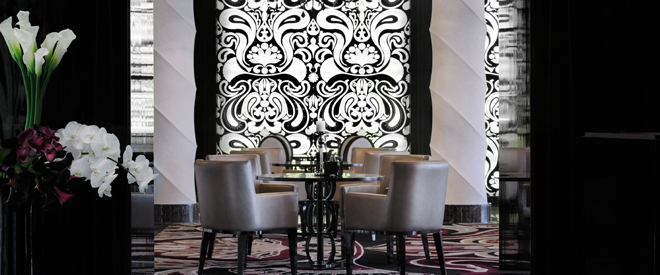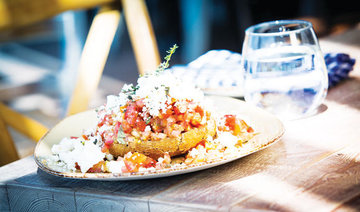Dubai is a foodie’s paradise. From delectable fine dining to scrumptious street-food offerings, you can eat your way around the city and still find space for dessert. So what is missing? A Michelin Guide of course.
Rumors have been swirling that the city is set to get its very own Michelin rating system, sparked by comments made by Michael Ellis, international director of Michelin Guides, at the Global Restaurant Investment Forum last year. Ellis said his company was on its way to creating a guide specifically for Dubai, but remained tight-lipped on the details.
Michelin stars are awarded to restaurants of outstanding quality in what is known as the Michelin Red Guide, with one star awarded to restaurants with very good cooking in their category, two stars for restaurants with excellent cooking, and the coveted three stars going to restaurants with exceptional cuisine. Michelin awards and retracts stars annually based on visits by their anonymous inspectors, whose grading methodology is a closely guarded secret.
The prestigious French guide actually began as a handy guidebook for Michelin tire customers in France in 1900. It was the brainchild of the Michelin brothers, who sought to “provide motorists traveling through France with all the useful information to supply their automobile, to fix it, where to sleep and eat, and which means exist to communicate, by mail, telegraph or telephone,” according to Christie’s auction house, which put a set of guides under the hammer in 2016.
Fast forward to the 21st century, and food buffs the world over may have spurted out their soup in shock when two street-food hawkers in Singapore became the world’s first such eateries to gain Michelin stars. Hong Kong Soya Sauce Chicken Rice And Noodle, and fellow street-food stand Hill Street Tai Hwa Pork Noodles, were awarded one star each in the Michelin Guide Singapore.
The push eastward is relatively recent, as until 2006 Michelin’s country guides only covered Europe. The hot question now is whether the cultural and culinary melting pot of Dubai is next on the list. It is home to eateries headed by a slew of Michelin-star chefs, but the city is yet to boast a restaurant with a sparkling star of its own as they can only be awarded in places where Michelin Red Guides are published.
Although Michelin declined comment, telling Arab News they do not remark on potential development strategy, one Dubai-based restaurant critic and writer thinks the time has come for the city to be recognized for its food chops.
“The food and beverage industry in Dubai has well and truly come of age in the last two years or so. There have been noises about how vibrant the restaurant scene here is for a long time, but it’s only now that it has acquired a gravitas that’s worthy of recognition by the likes of Michelin,” Sudeshna Ghosh told Arab News.
Ghosh points to the emergence of original, high-quality, home-grown concepts, and a shift away from restaurants being run by hotels, as reasons behind the uptick in excitement over the local food scene. “However,” she cautioned, “it’s important to note that it’s early days, and it will take some time before there’s a critical mass of restaurants that offer a Michelin-quality experience comparable to, say, New York or Paris.”
The industry insider tips her head to several Dubai-based restaurants that she thinks are strong contenders for a star. “Play, and the sister venue The Experience, are definitely strong contenders. Zuma, the only venue on the World’s 50 Best list, is also a definite. Apart from that, I’d say some that are worth looking into are Tresind/Carnival by Tresind; Hakkasan; La Petite Maison; Novikov; and Aseelah, which serves up Emirati food.”
Meals or wheels? The relationship between the tire company and the guide
You would be surprised to find out that the renowned Michelin restaurant guide actually started as a road atlas for Michelin tire customers in France in 1900. At the time, road trippers were in need of a guide that could point out the most appealing restaurants on their route, and tire manufacturer Michelin was happy to oblige.
The first edition saw almost 35,000 copies printed, and contained useful information for motorists, including a list of hotels, groceries, bakeries, hardware stores and instructions on how to fix and change tires.
In 1931, ratings featured the current system of three stars for the first time, with the definitions becoming clear and definitive in 1933. One star indicated a good place to stop on your journey, and was awarded to a very good restaurant in its category. Two stars meant excellent cuisine, indicating dishes of outstanding quality worth a detour. Three stars were awarded to a restaurant worth a special journey, where diners could expect to eat very well.
Although production of the guide was suspended during both world wars, the 1939 edition of the guide was reprinted by the US military in 1943, just before the June 6 invasion of Normandy the following year, as it was deemed the most up-to-date map available to the armed forces.
Michelin-starred chefs’ restaurants that Arab News recommends
• Tom Aikens’ Pots, Pans and Boards
More of a casual and rustic spot, this eatery, located in The Beach @ JBR, has a good selection of meat, fish and chicken options that arrive in, you guessed it, pots, pans and boards.
• Gordon Ramsay’s Bread Street Kitchen
This restaurant at Atlantis, The Palm offers British cuisine with a relaxed, family friendly vibe.
• Yannick Alleno’s Stay
Although this is on the fancier end, with a strict dress code and no children under the age of 9 allowed, the food is more than enough to delight you at this One & Only The Palm eatery.

• Jason Atherton’s Marina Social
Marina Social dubs itself a celebrator of “de-formalized dining,” and offers a contemporary British-Mediterranean menu. It is located in the InterContinental Dubai Marina.
• Virgilio Martinez’s Lima
Peruvian chef Martinez replicated his famed restaurant in London in the heat of Dubai in the City Walk complex, and is credited with bringing the cuisine to the world’s attention.
• Gary Rhodes’ Rhodes W1
Rhodes was awarded a Michelin star for a restaurant in London in 1996, and has since brought his brand of British cooking to Dubai’s Grosvenor House.

• The Croft by Darren Velvick
The Croft was inspired by Velvick’s own childhood upbringing in a rural country village and is the home of great English cuisine in Dubai.






























